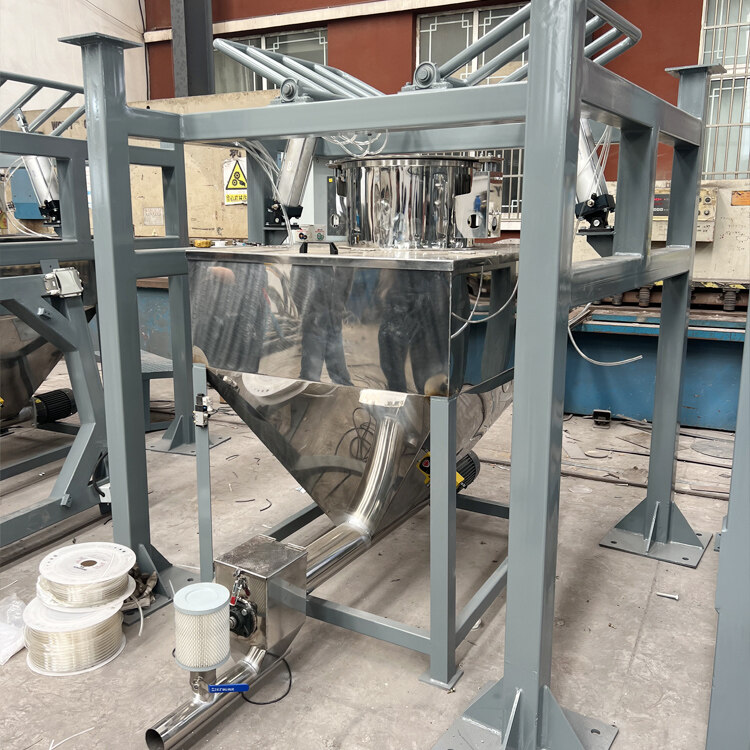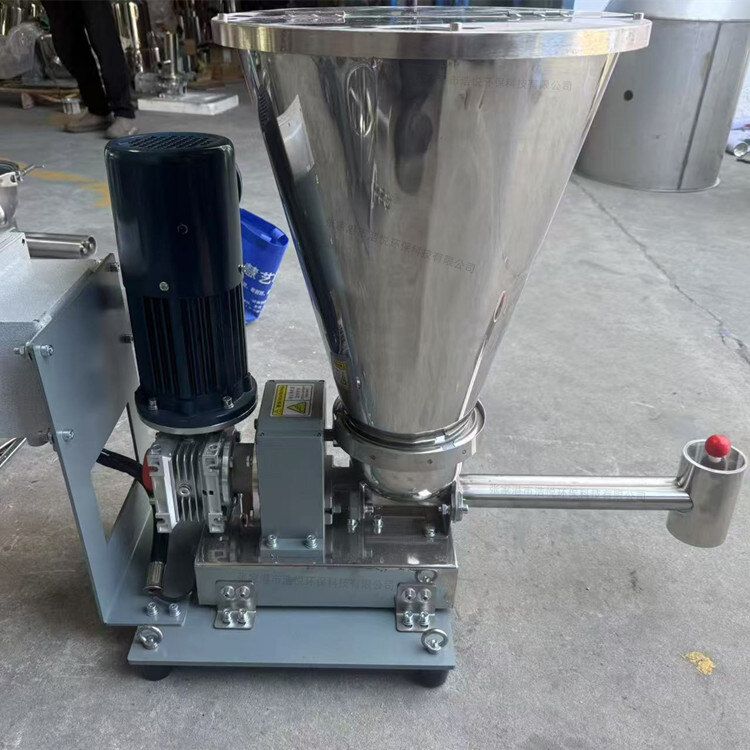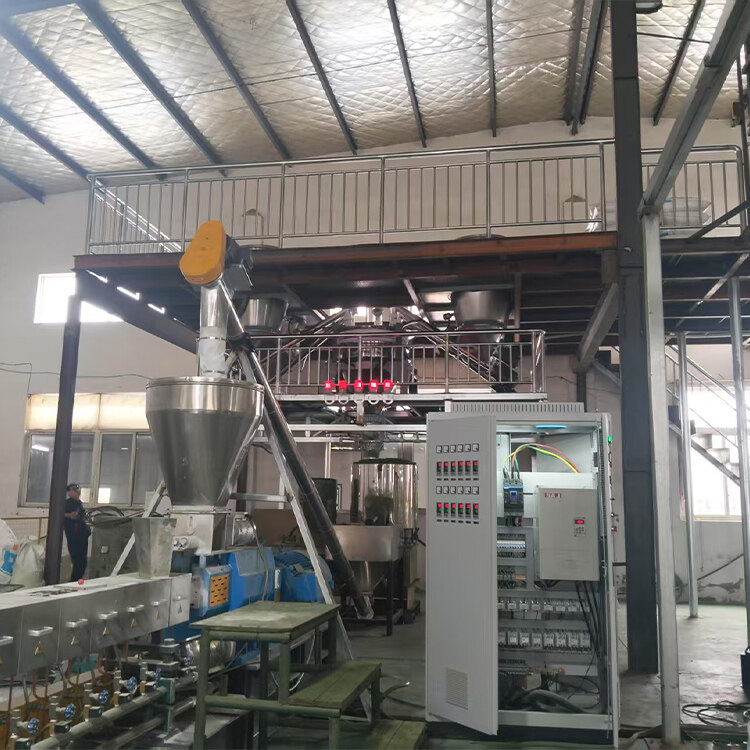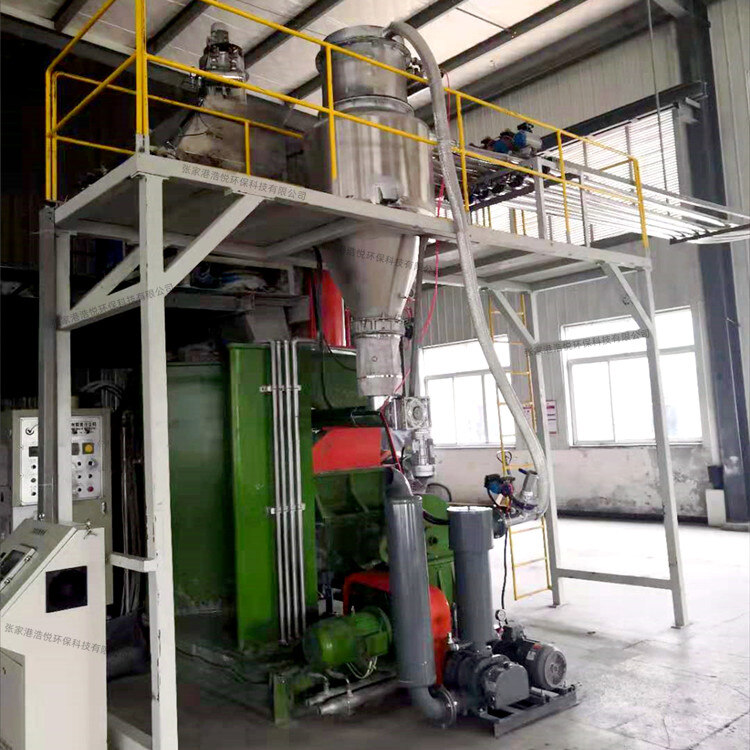- Introduction to automatic batching machine and fully automatic batching machine equipment
- The powder metering system tells you about the introduction of the mixing and drying machine
- 1000kg vacuum feeding machine
- Fully automatic small material batching system
- Research on Innovation of Automatic Weighing Machine Technology
- Design and operation of automatic batching system using PLC, industrial computer and frequency converter
Dust-free feeding station
- Category:Feeding station
- Hits:144次
- Release Date:2025-06-30
- Share:
- Inquiry
- Details
In the modern industrial production process, with the continuous improvement of production environment cleanliness and product quality requirements in industries such as food, pharmaceuticals, and chemicals, the problem of dust pollution caused by traditional feeding methods has become increasingly prominent. As an innovative equipment, the dust-free feeding station achieves dust-free operation of materials during the feeding process through advanced sealing technology, efficient dust removal system, and intelligent control, effectively ensuring the safety of the production environment, stable product quality, and the health of operators. The following will provide a comprehensive and in-depth introduction to the dust-free feeding station from the aspects of equipment structure, working principle, core advantages, application scenarios, and development trends.
1、 Structural composition of dust-free feeding station
The dust-free feeding station mainly consists of four core parts: material receiving unit, dust removal and purification unit, auxiliary operation unit, and intelligent control unit. These parts work together to form a complete dust-free feeding system.
(1) Material receiving unit
The material receiving unit is the primary link for materials to enter the system, and its design forms vary depending on the material form (powder, particle, block, etc.) and production requirements. For manual feeding scenarios, ergonomic feeding ports are usually set up, with optimized height and tilt angle to facilitate unpacking and feeding operations for operators. The feeding port is equipped with a fast opening and closing device with excellent sealing performance, such as a pneumatic sealing door or an electric sliding door, which quickly closes before and after material feeding, minimizing dust spillage. Internally, there are auxiliary components such as diversion grooves and vibration hoppers. The diversion grooves can guide materials to smoothly slide downstream to the conveying equipment, while the vibration hoppers help materials with poor fluidity to be quickly unloaded through vibration, avoiding material residue and blockage, ensuring a smooth and efficient feeding process.
(2) Dust removal and purification unit
The dust removal and purification unit is the core module for achieving dust-free operation in the dust-free feeding station, mainly composed of negative pressure fans, filtration devices, and dust collection systems. The negative pressure fan generates a stable negative pressure environment (usually maintained at -500Pa to -1000Pa), and quickly sucks the generated dust into the dust removal pipeline during material unpacking and feeding. The filtering device adopts efficient pulse bag filter or filter cartridge dust collector, with a filtering accuracy of over 99.9%, which can effectively intercept dust particles at the micrometer or even sub micrometer level. The collected dust falls into the dust collection bucket or box under the action of gravity and airflow. The dust collection device has a quick detachable structure, which is easy to clean and maintain regularly, ensuring the continuous and efficient operation of the dust removal system. Some high-end dust-free feeding stations are also equipped with secondary dust removal devices to further enhance the dust removal effect and ensure that the emitted air meets strict national environmental standards.
(3) Auxiliary operating unit
The auxiliary operation unit aims to improve the convenience and safety of operation, including lighting systems, anti-static devices, material storage platforms, etc. The lighting system provides sufficient and uniform light for the feeding area, allowing operators to clearly observe the material feeding situation and avoid operational errors caused by poor visibility; The anti-static device eliminates static electricity generated on the surface of materials and equipment in a timely manner through grounding wires and anti-static coatings, preventing dust accumulation caused by electrostatic adsorption and avoiding safety hazards caused by static electricity, especially suitable for feeding scenarios of flammable and explosive materials; The material temporary storage platform can temporarily store materials to be delivered, optimize the operation process, and improve work efficiency.
(4) Intelligent control unit
The intelligent control unit is based on PLC (Programmable Logic Controller) or industrial computer, and is equipped with an intuitive touch screen human-machine interaction interface (HMI). Operators can easily set parameters such as the speed of the negative pressure fan, the frequency and time interval of pulse dust cleaning through the touch screen, to achieve precise control of the equipment's operating status. The system can monitor various operating parameters of the equipment in real time, such as fan current, filter device pressure difference, dust collection bin material level, etc. Once abnormal situations occur (such as fan failure, filter blockage, dust collection bin overflow), it will immediately issue sound and light alarms and automatically take corresponding protective measures, such as stopping the machine, switching to backup equipment, etc. In addition, the intelligent control unit also has data recording and storage functions, which can generate device operation logs and production reports, facilitating later maintenance management and production data analysis.
2、 Working principle and process
When the operator transports the material to the dust-free feeding station, they first open the sealed door of the material receiving unit, place the material on the guide groove or vibrating hopper, and perform unpacking operation. At the moment of unpacking, the negative pressure fan of the dust removal and purification unit is in a stable operating state. Under the action of negative pressure suction, the generated dust is quickly sucked into the dust removal pipeline and enters the filtration device for purification treatment. The material is guided by a guide groove or vibrating hopper and smoothly falls into the conveying equipment below (such as screw conveyor, belt conveyor, pneumatic conveying pipeline, etc.) to complete the feeding process. Throughout the entire feeding process, the negative pressure fan operates continuously to maintain a negative pressure environment in the feeding area, ensuring that dust is always in a controlled state and will not overflow into the workshop environment.
As the filtering device continuously intercepts dust, the dust on the surface of the filter bag or filter cartridge will gradually accumulate, leading to an increase in filtering resistance. When the intelligent control unit detects that the pressure difference of the filtering device reaches the set threshold, it will automatically start the pulse cleaning program. Compressed air is instantly sprayed into the filtering device through a pulse valve, and the dust attached to the surface of the filter bag or filter cartridge is removed with strong impact force, causing it to fall into the dust collection bucket. After the dust cleaning is completed, the equipment will resume normal operation and continue with the next round of dust-free feeding operations.
3、 Core technological advantages
(1) Excellent dust control capability
The dust-free feeding station can control the dust concentration in the feeding area at an extremely low level through precise negative pressure control and efficient filtration technology, effectively improving the workshop production environment and protecting the health of operators. In practical applications, after using a dust-free feeding station, the dust concentration in the workshop can be reduced from above 50mg/m ³ using traditional feeding methods to below 2mg/m ³, fully meeting occupational health and safety standards and environmental protection requirements.
(2) Accurate material delivery
The design of the material receiving unit's diversion groove, vibration hopper, etc. ensures that materials can be smoothly and completely delivered to downstream equipment, reducing material residue and waste. At the same time, a stable negative pressure environment avoids excessive suction of materials into the dust removal system, further improving the accuracy of material feeding and saving production costs for enterprises. According to statistics, the use of dust-free feeding stations can reduce material waste rates by 30% to 50%.
(3) Easy to operate and safe and reliable
Ergonomic design and intelligent control system enable operators to easily get started and reduce labor intensity. Multiple safety protection measures, such as sealed door interlocking devices, overload protection, emergency stop buttons, anti-static design, etc., comprehensively ensure the personal safety of operators and the stable operation of equipment.
(4) High flexibility and adaptability
Customized design can be carried out according to different industries, material characteristics (such as particle size, flowability, corrosiveness, flammability, explosiveness, etc.), and production process requirements. From the selection of equipment materials (such as stainless steel, food grade plastics, corrosion-resistant alloys, etc.) to the feeding method, dust removal scheme, and configuration of conveying interfaces, all can meet diverse production needs and are widely applicable to many industries such as food, pharmaceuticals, chemicals, electronics, and new energy.
4、 Application scenarios
(1) Food processing industry
In the production process of food additives, condiments, baking materials, etc., the dust-free feeding station is used to accurately put sugar powder, salt, essence, flour and other materials in small packages or in bulk, effectively avoid dust pollution of food raw materials, and ensure food safety and product quality. At the same time, a clean production environment helps to meet the strict hygiene standards of the food industry (such as HACCP, ISO 22000, etc.) and enhance the brand image of the enterprise.
(2) Pharmaceutical industry
Pharmaceutical production requires extremely high environmental cleanliness and material purity, and dust-free feeding stations can be applied to the dispensing of drug raw materials and auxiliary materials in sterile workshops. Through strict sealing design and efficient dust removal and purification system, cross contamination is prevented to ensure that the drug production process complies with GMP (Good Manufacturing Practice) requirements, providing strong guarantees for drug quality and safety.
(3) Chemical industry
Chemical production involves a large amount of powdered and granular chemicals, and some materials also have characteristics such as flammability, explosiveness, toxicity, and harm. The dust-free feeding station can effectively control the flying of dust, avoiding safety accidents and environmental pollution caused by dust leakage. Meanwhile, precise material placement helps ensure the quality stability of chemical products and improve production efficiency.
(4) Electronics and New Energy Industry
In the production process of electronic materials (such as electronic grade silicon powder, photoresist raw materials) and new energy materials (such as lithium battery positive and negative electrode materials, photovoltaic materials), the cleanliness requirements for materials are extremely high. The dust-free feeding station can ensure that materials are placed in a dust-free environment, prevent dust particles from having adverse effects on the performance of precision electronic components and new energy products, and improve product yield and market competitiveness.
5、 Development Trends
In the future, dust-free feeding stations will continue to develop towards intelligence, integration, and greening. In terms of intelligence, by introducing Internet of Things (IoT), big data analysis, and artificial intelligence (AI) technologies, remote monitoring, fault prediction, and diagnosis of equipment can be achieved, as well as automatic optimization of operating parameters based on production data; In terms of integration, it deeply integrates with the enterprise's MES (Manufacturing Execution System) and ERP (Enterprise Resource Planning) systems to achieve collaborative linkage between production planning, material management, and feeding operations, and improve the intelligence level of production management; Greening is reflected in the adoption of energy-saving equipment components (such as high-efficiency energy-saving fans, low-energy filtration devices), optimization of system operation strategies to reduce energy consumption, and strengthening the recycling and reuse of dust to reduce waste emissions and promote sustainable development of the industry.






